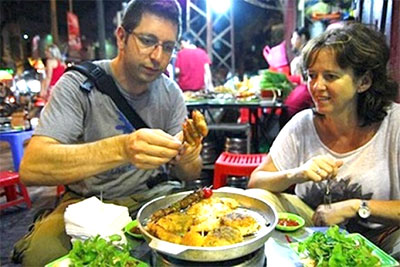La combinazione armoniosa della “battere” (a small wooden sticks beaten on a small bamboo bar) and the “giorno dan” (a Vietnamese plucked lute with three strings) and the vocals makes “come tru” a perfect performance.
And such traditional art form has become Intangible Cultural Heritage of UNESCO world.
First introduced in our country in the early 11th century, Ca Tru has become popular since the 15th century. Ca tru was so – called ‘Hat a dao’ (name of a famous songstress in the Lys times), “Cappello co dau“, “Cappello Granchio nutrizione” (singing for relivious rituals) and so forth. In ancient times, “Cappello Granchio nutrizione” era comunemente eseguita a cerimonia di premiazione in modo che fosse così - chiamato “cappello“. The songstress sat in the middle of the yard whilst the royal officials who sat on the two sides beat gongs and drums. Good vocalists received a tag, called ‘tru’. The numbers of the tags were also the bonuses for the female vocalists after the performance. As time went by, “come tru” has become a unique and highly developed chamber music in Vietnam. “Ca tru” creates the harmonious combination between music, poetry, love and deep thoughts. It won upon hearts of all art lovers not only in the country but also all over the world.

Ca tru is a unique type of music which has been transmitted and evolved by a process of oral transmission or performed by custom over a long period of time. ‘Ca tru’ has many melodies that are sung differently but the chief is singing – reciting: a female singer, a male musician playing the “giorno dan”, and the spectator (often a scholar or connoisseur of the art) who strikes a “a Chau” (praise drum) in praise (or disapproval) of the singer’s performance. The music accompaniment consists of a ‘phach’ – a bamboo instrument beaten with two wooden sticks, ‘trong chau’ – a drum beaten by a member of the audience in appreciation or comment, and ‘dan day’ – a long – necked lute. The three instruments sound in harmony which in turn creates poetical, musical, rhythmic and melodious songs. Space, acting, musical instruments, and the incrediblevocals make ‘ca tru’ distinctive. The vocalists are of great vocal talents but also very hard – working. To perform as expected, the singer must practice very hard and know many tunes. Not everyone would like ‘ca tru’ for the first time. Only the ones who listened to it for a long while can understand the soul of ‘ca tru’.
‘Ca tru’ is original, artistic and religious – oriented. ‘Ca tru’ music school, ‘ca tru’ – famiglie che cantano e ‘tru Ca’ – worshiped temples… It was commonly performed in communal houses and private homes. ‘Ca tru’ spread through the country from Northern Vietnam to North Central regions such as Bac Ninh, Phu Tho, Ha Noi, Hai Phong, Nam Dinh, Thai Binh, Nghe An, Quang Binh … ‘Ca tru’ was sang differently in different regions. ‘Ca tru’ was named by UNESCO as the Intangible Cultural Heritage on 01/10/2009.
What could be more interesting than while wandering around small rustic lanes in Vietnamese village, suddenly you listen to the sound of the music accompaniment and the vocals of the songstress? You must be charmed with the mysterious lyrics and the melodious tunes. It is an unique intangible cultural space which deserves to be honored by the whole world and preserved by Vietnamese generations for ever after.




